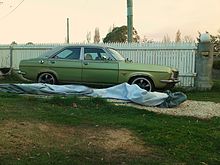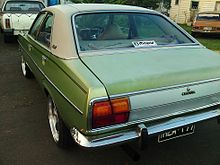- Chrysler Centura
-
Chrysler Centura Manufacturer Chrysler Australia Production March 1975–1978 Assembly Keswick, South Australia Successor Chrysler Sigma[1] Class Mid-size car Body style 4-door sedan Layout FR layout Engine 2.0 L Type 180 I4
3.5 L Hemi I6
4.0 L Hemi I6Wheelbase 2,660 mm (104.7 in)[2] Length 4,580 mm (180.3 in) Width 1,730 mm (68.1 in) Height 1,430 mm (56.3 in) Curb weight 1,105–1,125 kg (2,436–2,480 lb) Related Chrysler 180 The Chrysler Centura was a midsize car built by Chrysler Australia, based on Chrysler Europe's Chrysler 180 but also available with larger Australian made Hemi Sixes. About 15,000 Australian Centuras were built between 1975 and 1978.
Contents
Development
Engineers from Chrysler Australia and Simca considered modifying the body of a Chrysler 180 sedan and shortening the drive train so they could place the Australian 6-cylinder Hemi engines further back in the body but instead decided to lengthen the nose as Chrysler Australia apparently felt this created a more aggressive and better looking car. It also meant less changes were needed to "Australianise" the car, making it economical to assemble. Additional, largely cosmetic changes included a new grill, headlights, bonnet and rear panel and taillights.
To compensate for the Hemi engine's extra weight at the front of the car a brake proportioning valve was fitted towards the rear of the car, to compensate for weight shifts. When the car "nose-dived" under heavy braking, a mechanical link connected to the proportioning valve reduced the brake pressure on the rear wheels, to prevent them from locking up and causing the back of the car to slide around.
Chrysler also experimented with fitting a 5.2 litre (318 ci) American made V8 but decided that the body lacked the rigidity to cope with the larger engine and the V8 version never went into production.
KB and KC Centura
The KB Centuras sold and assembled in Australia not only had a 1,981 cc version of the 4-cylinder Simca engine but were also available with Australian made 6-cylinder pushrod 3,523/4,014 cc hemi engines and BorgWarner 3-speed automatic and 3- or 4-speed manual gearboxes. The four offered 122 hp (SAE), the sixes 142/167 hp (SAE) respectively.[2] The KB series was sold in XL and GL trims, the latter having more equipment including cloth trim seats and optional vinyl roofs. The KB model's European pedigree was obvious with instrumentation in the opposite order and steering column controls on opposite sides. All KB cars came equipped with a tachometer (whereas later KC cars only gained a tachometer through special order, or as part of the Sports option package) Interior flow ventilation was improved over the larger Valiant models, as the Centura had two face level ventilation outlets. The sixes also came with larger brakes (60 mm ventilated front discs and 25.4 mm rear finned drums) and a tandem brake reservoir. The six cylinder Hemi cars used a 5 stud wheel bolt pattern, and the 4 cylinder cars used a 4 stud wheel bolt pattern and only featured solid unventilated brake discs. All Centura models were factory fitted with rack & pinion steering. Rumors still exist of some Centura cars leaving the factory with the E33 option code, denoting fitment of a 4.3 litre 265 Hemi engine. No cars have ever been verified to have left a dealership with factory fitment of the 265 Hemi engine and E33 option code.
Problems
The manual six-cylinder Centuras' firewalls were not up to the heavier duty clutches needed for the sixes; flexing considerably and sometimes cracking. Early KB Centuras also experienced quality issues with interior fixtures, with door trims cracking, and torn vinyl trim near stitching lines not uncommon. KB 6-cylinder models have also been known to catch fire under bonnet, due to the long loom required from battery to starter motor, which are on opposite sides of the bay. This is caused through looms rubbing on metallic clips located on the firewall. Later KC cars featured a revised rubberised coating on these wiring loom clips, which helped alleviate this issue. No Centura models were fitted with starter motor relays, which simply put the load onto the ignition switch when cranking instead, which reduced the ignition switch life in some cars. Traction in wet weather proved to be poor, with an open differential, relatively large six cylinder Hemi engine and very light weight over the rear wheels.
The importation of the bodies from France into Australia was complicated in 1973 by industrial action, with dockside unions protesting against French Pacific island nuclear testing. Many early KB bodies spent months on wharfs exposed to salt air creating corrosion problems later in these cars' lives. As the union bans lasted 2 years some KB Centuras spent this long on the wharfs.
In addition to the union bans on French imports, parts supply and local Chrysler support for used vehicles also became more complicated when in 1978, Chrysler Europe went bankrupt and was taken over by Peugeot. This Peugeot takeover was soon followed by several French Peugeot/Talbot factory strikes worsening the problems in sourcing parts in Australia. The mix of metric and imperial fasteners used on the 6-cylinder cars and their combination of French and Australian parts also makes them challenging vehicles to maintain.
In the market
Six cylinder cars sold four to one in the Australian market over the four cylinder cars. They had a reputation for providing reasonably decent handling, good torque and outstanding acceleration. Sports options available on Centura models ranged from dealer fitted stenciled sports stripes (bonnet and sides), special 'Boca-Raton' striped cloth seats and styled steel or alloy wheels. Most of the interior and exterior dealer options from the larger Valiant models were applicable to the Centura, from the dealership.
The Centura's main competitors in Australia were 4- and 6-cylinder Australian made versions of the Ford Cortina and General Motors' LH Holden Torana and Sunbird. The Centura boasted much more interior room and boot space than these main rivals, along with a more favorable power-to-weight ratio. Centura's were also seen to compete to a lesser extent with larger bodied Australian Holdens, Chrysler Valiants (including the sporting Charger coupe) and Ford Falcons. Most competitors, although often lacking the fierce acceleration of the 6-cylinder Centura, proved less rust prone and generally had more modern styling. In retrospect the rather compact Centura was not a typical 1970's medium-sized car. It wouldn't be until after the cancellation of the Centura, when Holden released the Commodore in October 1978, for the market to have a vehicle with similar internal dimensions to the Centura.
Chrysler Australia was being starved of funds by its troubled American parent at this time, leaving the larger Valiant sedans persisting with the same chassis platform and basic body shape and interior (Valiants did not have face level flow through vents, unlike those in the Centura) for many years. This created an old-fashioned image of the Australian Chrysler-Valiant brand that may have also have adversely impacted Centura sales. The Chrysler 180 design was also rather dated by the time the cars arrived in the Australian market (later than intended), further adding to the old-fashioned image of the brand. The bigger Valiants were still popular with rural Australians who seemed to prefer large powerful American style cars, but the Centura didn't have the size or style to meet the needs of that market either.
KC Centura
The KC model (from June 1977 to the end of 1978) series dropped the 2.0 and 3.5 engines, replacing them with a low compression (7.6:1) 4.0-litre Hemi engine which ran on standard grade fuel and aided fuel economy, and a 4.0-litre high compression 2 barrel (9.0:1) version of the Hemi for more performance and towing ability. The KC was also more Australian, using VDO gauges, Valiant style steering wheel, steering column and various other parts from the larger Australian Valiant lineup. While the 3.5-litre had a 3.23:1 differential ratio, the 4.0 got a 2.92:1 ratio. The KC was offered in GL or upscale GLX trims, along with the addition of sports package options.
By 1979, the Centura had been replaced by the 4 cylinder Chrysler Sigma, of Mitsubishi origins.[1]
Centuras today
Some Australian enthusiasts later fitted larger 4.3 litre Hemi sixes to their cars (some even adding triple or four barrel carburetors, limited-slip differentials and other performance parts from the sportier or R/T versions of the larger Australian made Valiant Charger). Others have fitted various Chrysler V8's ranging from Chrysler's 5.2 litre 318 smallblock V8, up to the 7.2 litre 440 bigblock V8. Due to the light weight of the cars, retrofitting the larger V8 engines gives formidable performance in a straight line.
Centuras are now very rare on Australian roads, although they appear more common in South Australia. This is probably due to an enduring loyalty to the Chrysler brand as they had a manufacturing plant in that state before selling it to Mitsubishi in 1980. The nuclear bans impact on production and parts supply, subsequent rust problems, cracking firewalls, extremely light weight over the rear of the car and difficulty early in the cars' used sales life in getting parts from France were probably all factors that contributed to their relatively rapid disappearance from Australian roads. The 1977-1978 4-litre Hemi KC with either manual or auto transmission and sports wheels is now the most sought after by enthusiasts and collectors.
References
Categories:- 1970s automobiles
- Chrysler vehicles
- Sedans
- Cars of Australia
Wikimedia Foundation. 2010.



